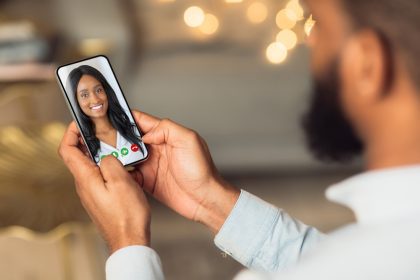In a world shaped by connectivity, long-distance relationships have evolved from rare, burdensome exceptions to increasingly common and, in some ways, even aspirational arrangements. As video calls, text messages and social media shrink emotional gaps, couples have discovered new ways to stay close while being physically apart. But this shift hasn’t just made distance more manageable—it has transformed what people expect from romantic relationships entirely.
Redefining commitment
Long-distance relationships used to be viewed as temporary states until one person could relocate. But technology, mobility and a shift in cultural values have reframed them as legitimate, even desirable ways to experience love. For some, this separation allows personal growth, career exploration and emotional independence while still maintaining intimacy.
The definition of commitment has shifted. It’s no longer just about shared geography or physical presence. Today’s partners value emotional transparency, digital consistency and a shared vision of the future. Couples can live in different time zones and still feel deeply connected—sometimes even more than couples who live together but lack communication.
This redefinition has increased the emphasis on emotional availability and quality time, which no longer require proximity to exist.
Digital intimacy rituals
Distance once meant waiting for letters, costly long-distance calls and agonizing silences. Now, it means morning texts, shared playlists, virtual movie nights and checking in via video chat on a lunch break. Long-distance love stories have moved from tragic to tender.
Couples are developing new rituals rooted in digital intimacy. From sending voice notes during commutes to playing online games together, daily interactions have taken on new meaning. The expectations around what “being there” looks like have also changed. You don’t have to be physically present to be emotionally involved.
Interestingly, some long-distance couples report more meaningful conversations and deeper emotional vulnerability. There’s an intentionality that comes from knowing you can’t rely on touch or presence—so words, consistency and time spent truly listening take the front seat.
Independence as relationship strength
Perhaps the most profound expectation shift lies in how people value independence within a relationship. Long-distance couples are often required to develop strong individual routines, social lives and coping strategies. In turn, these habits build resilience, maturity and emotional regulation.
This has led to a cultural shift where dependence isn’t romanticized; instead, mutual autonomy is celebrated. Two complete individuals choosing each other, not out of habit or convenience, but out of deep desire and intention—that’s the new romantic ideal.
It’s changed the way people date, too. Even couples who live in the same city may prefer more time apart, reflecting a model inspired by long-distance frameworks. The idea that you must do everything together has faded. Instead, sharing separate lives that intertwine meaningfully is the new expectation.
Elevated communication standards
Long-distance relationships demand better communication—or they don’t survive. This need has raised the bar across the board. In-person relationships are now expected to match the level of effort, clarity and consistency that long-distance couples are known for.
Modern relationships prioritize:
- Regular emotional check-ins
- Clear texting etiquette
- Thoughtful digital gestures
- Scheduled quality time
In a culture that’s grown more conscious of emotional labor, people want effort and presence—even if virtual. This change has rippled across dating culture. If someone hundreds of miles away can make you feel seen, heard and valued, why should someone next door get a pass for being inattentive?
Evolving trust and boundaries
One of the most challenging parts of long-distance relationships has always been trust. With physical absence, insecurity can grow if expectations and boundaries are not clearly defined. But modern long-distance couples are finding ways to navigate this with intention and transparency.
Trust is now rooted less in control and more in mutual respect. Clear boundaries, open conversations about needs and discussing how social media fits into the relationship have become normal expectations.
What’s also changing is the ability to see jealousy as a trigger to explore rather than suppress. Couples are asking more questions like “Why do I feel this way?” and “What do I need to feel secure?” Long-distance has ushered in more emotionally intelligent dialogue that’s redefining what emotional safety looks like.
Career paths and flexible timelines
With global job markets, study abroad programs, remote work and location-independent lifestyles, physical distance between partners is more common than ever. Today’s generation isn’t afraid to delay cohabitation or even marriage for career goals or personal development.
This shift has changed the pacing of modern relationships. Instead of rushing to move in or get married, couples are learning to be patient and see long-distance as part of a long-term investment in each other. Some relationships remain long-distance for years—not because they’re stuck, but because both people value individual growth alongside partnership.
Romantic timelines have expanded. The once-standard progression from dating to moving in has become more flexible and personalized.
Digital love languages
The traditional five love languages have been reinterpreted in long-distance relationships. Now, love might be expressed through carefully timed video calls, curated memes, digital reminders or surprise food deliveries from miles away.
People are learning to adapt their expressions of affection based on medium and context. What was once thought to be impossible—expressing intimacy without touch—has become entirely possible with effort and creativity.
This digital translation of love languages has inspired people in close-proximity relationships to get more thoughtful and proactive. Couples now realize that thoughtfulness isn’t about grand gestures—it’s in the small, consistent moments of care.
Global connections through technology
Dating apps have made it normal to form connections with someone who lives in another city—or even country. While previously long-distance was often a result of circumstance (college, job relocations, military), it’s now also a choice.
Some individuals specifically seek out long-distance matches to create space, avoid local dating scenes or build deeper connections without immediate pressure. While not for everyone, this choice reflects an openness to unconventional relationships—and it’s altering cultural norms.
This new era of global dating means people are more curious, more patient and more willing to explore what love looks like outside their comfort zone.
The reunion adjustment
What many don’t anticipate is that the hardest part of a long-distance relationship might come when it ends—when the couple finally lives in the same city or moves in together. Expectations built during time apart don’t always translate seamlessly.
Suddenly, all the solo rituals, private spaces and long-distance rhythms are gone. Couples must renegotiate what closeness means in physical terms. Merging lives can be both exhilarating and disruptive.
But for those who’ve built strong communication, resilience and emotional maturity during their time apart, these growing pains often lead to even deeper partnership.
A more intentional approach to love
Long-distance relationships are no longer cautionary tales. They’ve become blueprints for the kind of communication, trust and self-awareness that make any relationship thrive—near or far.
Modern love is more fluid, adaptive and centered around emotional partnership rather than physical routine. As a result, people are more intentional about who they love and how they show it.
In a world that feels more connected and fast-moving than ever, long-distance has slowed love down just enough to make people more thoughtful. It’s no longer about closing the gap quickly—but about making the time and space between meaningful.
This story was created using AI technology.










